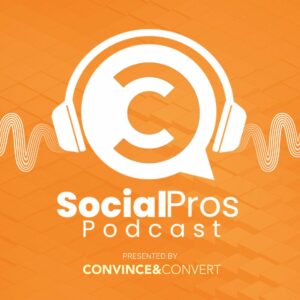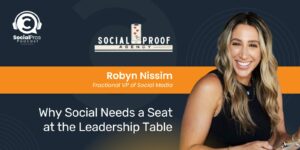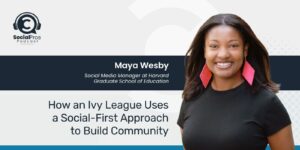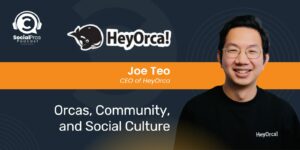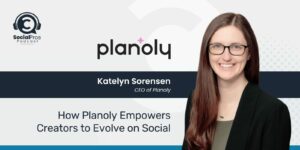Hosted By
About Social Pros Podcast:
Social Pros is one of the longest-running marketing podcasts in existence (10 YEARS and counting), and was recently recognized as the #1 Audio/Podcast Series by the Content Marketing Awards.
Our purpose? Making sure that we speak to real people doing real work in social media.
Listeners get inside stories and behind-the-scenes secrets about how teams at companies like Google, Reddit, Glossier, Zillow, Lyft, Marvel, and dozens more, staff, operate, and measure their social media programs. With 600+ episodes, the Social Pros Podcast brings the humanity of social media to the forefront, while providing incredibly useful marketing strategies that listeners can immediately implement.
Follow Social Pros on LinkedIn.
To inquire about becoming a guest or show sponsor, please email our Executive Producer, Leanna Pham, at leanna@convinceandconvert.com.
Apple Podcast Reviews:
The Social Pros podcast has quickly become a favorite in my feed! I'm consistently impressed by the engaging conversations, insightful content, and actionable ideas. I truly learn something every time I listen!
@Arlie KThis is absolutely an awesome listen for anyone in communications or social media!!
@Will31CThis podcast has become one of my staple weekly podcasts for learning about marketing! Love the conversations that they have and it's always enjoyable and educational!
@Simonstone95Love the podcast - informative, in depth and spot on for any business size.
@MissTriathlon
Ann Handley, Chief Content Officer at MarketingProfs and co-writer of Content Rules, joins the Social Pros Podcast live from the New Media Expo in Las Vegas this week to discuss the on-going visual renaissance, leaving the “person” out of “personable” in social, and the struggle to keep the customer first. Read on for some of the highlights […]

Ann Handley, Chief Content Officer at MarketingProfs and co-writer of Content Rules, joins the Social Pros Podcast live from the New Media Expo in Las Vegas this week to discuss the on-going visual renaissance, leaving the “person” out of “personable” in social, and the struggle to keep the customer first.
Read on for some of the highlights or listen below for the full podcast.
Listen Now
Click the play button to listen here:
[podcast]http://socialpros.podbean.com/mf/web/z3bv4a/SocialProsEpisode49.mp3[/podcast]
Download the audio file:
http://socialpros.podbean.com/mf/web/z3bv4a/SocialProsEpisode49.mp3
The RSS feed is: http://feeds.feedburner.com/socialprospodcast
Find us on iTunes: http://itunes.apple.com/us/podcast/convince-convert-blog-social/id499844469
Please Support Our Sponsors
Huge thanks to data-driven social media management software company Argyle Social for their presenting sponsorship, as well as Infusionsoft, Janrain, and Jim Kukral at DigitalBookLaunch. We use Argyle Social for our social engagement; we use Infusionsoft for our email; Janrain is our crackerjack social integration company, and Jim is our guest host for the podcast (and a smart guy).
Social Pros Highlights For Your Reading Enjoyment, Thanks to Speechpad for the Transcription
![]()
Content and Social: Two Peas in a Pod
Jay: Obviously in the intervening years since you started ClickZ, we’ve had this whole rise of social media which really didn’t exist in a classic sense back then. So how do you think about it now, content versus social? Do you think of them as different, the same, or complementary? Since you’re so adept at both, how do you think about it strategically?
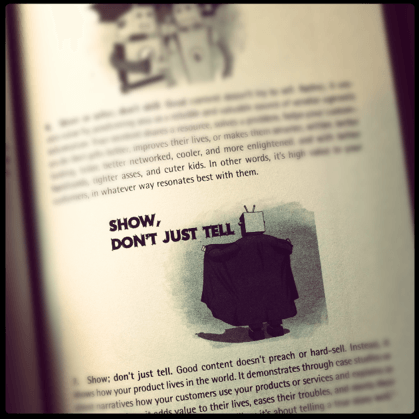
Ann: I think they’re very complementary, and I think of them as two sides of the same coin, essentially. I think that content is critical to any social strategy, and I think social is critical to any content strategy. So I definitely think they are “BFFs,” as my 16-year-old daughter would say.
But I get this question a lot where, “Should I think about content or should I think about social?” and really the answer is, yes. You’ve got to have a content strategy. You’ve got to know what you’re saying before you say it out loud is the way that I think about it. I think it’s important to think about what it is that you want to say, who you are as a company and how you want to position yourself, and what your larger story is before telling it on social.
Jay: How does that theory of hand and glove, content and social, manifest at MarketingProfs? What does it look like on your team in terms of folks responsible for content and then people responsible for social? What does that look like?
Ann: At MarketingProfs we do have a unique situation in the sense that our product is content. We don’t use content as content marketing. We sell content, so that’s what our value is. So the way it works at MarketingProfs is that essentially all of the content creators are also on social media.
The other side of that is that our marketers are also content creators. The people who we have marketing our events, people like Corey O’Loughlin and Jo Roberts and Nicole Rodriguez, they are also bloggers for us. So for us it’s very tightly intertwined.
There’s no one who’s solely responsible for social; it’s part of everybody’s job. But that said, Corey O’Loughlin, who is our marketing manager, she’s the one who updates the Facebook page, she’s deciding on the strategy there (with input from all of us). I’m @marketingprofs on Twitter so I kind of own that strategy there, but Corey and I work closely in terms of amplifying all the MarketingProfs content across all social networks.
Personal vs Personable
Jay: And you have been @marketingprofs on Twitter since the very beginning and now have 100,000-something followers, and richly deserved. Knowing what you know now and what has happened in social, would you, if starting from scratch today, be @marketingprofs again or would you be @annhandley?
Ann: Yeah, I would not be @marketingprofs again if I were starting it today. That’s something that I’ve searched my soul about because I do have 140,000 followers there on Twitter as @marketingprofs, and if I were to leave MarketingProfs – and I have no plans in doing so – the followers would stay with @marketingprofs. It’s the brand name.
Sometimes I struggle with this issue, though, because part of the opportunity of social is that we can show the people behind the brand, so that’s a wonderful thing. That’s what you and I are always telling everybody who comes to us for advice. But at the same time, it’s a tricky balance because on the one hand you want to show the personality behind the brand so it makes perfect sense that me, as kind of the face and the voice of MarketingProfs should be @marketingprofs. But at the same time, it doesn’t make sense because it’s not all about me.

Jay: Certainly because your handle is the company name, that adds even another layer of trickiness around that. But there’s no question that what I post to Twitter has changed over time. It’s sort of a skill because you say “humanize, humanize and use Twitter to be human” but yet if you’re successful with it, you must by definition become less human because the math of that makes you think twice about saying things.
When you start getting at scale, you think, “What percentage of this larger group of people really cares about cookies on my counter?” It’s a challenge. Let me back up and ask you the question this way. Do you think it’s that Twitter has changed, or is it that you have so many more followers on Twitter that Twitter has changed you?
Ann: I think it’s a little bit of both really. My attitude has shifted. And is that a result of Twitter shifting, of social maturing? Yes, probably a little of everything. But it used to be that I thought my job – at least as relates to social media and specifically Twitter – was that I should let people get to know me because I am the face of MarketingProfs.
So therefore, don’t you want to get to know me, don’t you want to see my dogs, don’t you want to know what book I’m reading? But I don’t think that’s true anymore. I think there’s a big difference between personal, which is what I used to share, and personable, which is what I do now.
My struggle with the original question, which is, “Would you do that again?” I have 140,000-something followers on Twitter. Would I have that if it was @annhandley, if it was just a decentralized committee tweeting on behalf of MarketingProfs, putting out our headlines, just doing that rote Twitter maintenance? I don’t think so. I think my efforts early on really did help pack that snowball so it had greater surface as it rolled down the hill.
Ann is Not Impressed

Jay: Lately you have been doing a lot more content and social programs outside of Twitter and doing interesting content, the “Ann is not impressed,” spoof of McKayla’s Olympic thing was super successful.
Do you want to tell people about that a little bit and sort of how that came about? Because it was really successful and it was almost a newsjacking play, right? It was so fast and so nimble and did so well. It was very admirable.
Ann: Yeah, and that actually came from Dani Hagen on our team, who is not a marketer but she does a lot of great stuff at the company. So she said to us, “You know what we should do?
We should do an ‘Ann is not impressed.’”
Of course that grew out of the McKayla Maroney famous “McKayla’s not impressed,” when she won the silver medal instead of the gold that she wanted and she made that famous smirk.
In order to highlight some marketing efforts that we find annoying: things like Nigerian spammers or even some crazy things like the Honey Boo Boo programming on Bravo, that kind of thing. We created this “Ann is not impressed” graphic and we created it originally as a series of Facebook uploads and then eventually created a slideshow from it and it was wildly successful. It was a fun thing to share on Facebook and on SlideShare and on our blog and so on, which brings me back to the earlier conversation we were having about the difference between personal and personable. That’s not personal but it was wholly personable.
Jay: It wasn’t strictly business.
Ann: It showed a sense of fun and a sense of play that MarketingProfs has, the way that we love our jobs, the way that we approach marketing and business. It’s a fun place to work, and that’s not always the way that B-to-B companies approach their content. So I think that’s really what we were trying to show there, and it was successful because: A) it was a bit of a newsjack, B) I’m sort of recognizable and it was a really funny picture, I thought, and C) it worked. It drove traffic, and that was fun.
Measuring Success
Jay: I’m glad you mentioned driving traffic. Because those kinds of programs don’t require a significant capital outlay but certainly there’s a cost associated in staff time, etc. Is that how you look at the effectiveness of that type of content, that it drove a bunch of traffic back to MarketingProfs.com? Is that sort of how you think about, “Yes, this was worth it”?
Ann: Yeah, well for us, our measure is always that we are trying to build our database. So most of our content is geared towards getting people to come to MarketingProfs. Not just because we love to see big traffic numbers but it’s really about, “How many people came here? How long did they stick around and did they give their e-mail address before they left?”
So in the case of “Ann is not impressed,” we put that on SlideShare where we have a lead capture form so we know exactly how many people looked at that and filled out their e-mail information to hear more from us. So when I say it was a success, that’s what we’re looking at.
I don’t have specific numbers for that but also know that a lot of our first time visitors come from Facebook.
We don’t count likes. We count shares. That’s really what we’re interested in so we’re interested in getting shares, and that “Ann is not impressed” thing did get a bunch of shares. It didn’t ultimately drive as many shares, ultimately, as the SlideShare deck did but, that said, in the macro we found that Facebook is a great place to prospect for new members who don’t know about us. So we’ve really focused a lot on creating shareable content there. That was before, by the way, their most recent update to EdgeRank so it’s not working so well for us anymore, but it had been working really well for us so we put a lot of resources into that for that reason.

Jay: The other one that you did even more recently, which I thought was hilarious, was when we had the imbroglio about Instagram’s Terms of Service change where you can use people’s individual Instagram photos to create ads and all that.
People were losing their head. You put together some content that imagined what it would be like to use people’s personal Instagram photos for advertising purposes and it was really, really funny.
Ann: Right. That was a situation where that was what the Terms of Service essentially said was that they could take your photos and sell them to brands who could use them for advertising. So what we did was we created a series of fake ads of what would that possibly be.
It was just like there was complete disconnect, and they were just so hilarious. I mean, just sort of mocking the concept of that Terms of Service shift. Always one of the tenets that we always try to exercise is “be human,” show that we have a sense of fun, of play, that we think business is a lot of fun, and that’s kind of part of who we are.
The Visual Revolution Here to Stay?
Jay: We’re talking about some of the more visually-oriented pieces of content with social activation strategies that MarketingProfs have done in the last six-eight months. I think there’s no question that all of this stuff is becoming more and more visual (with the possible exception of Twitter).
I think every other modality is starting to rely increasingly on visual communication. As somebody who has historically been a creator of written things, what do you think about that? Is this good news? Is it bad news? Does it scare you? Do you think it’s a snapshot in time or is it a trend that will continue?
Ann: No, I think it’s a trend. I think it’s fantastic because I think it’s really exciting, actually, to have the capacity for anybody to be able to tell a story visually, and that’s what all those platforms really give you. They allow even mere muggles to create magic, really, when it comes to photographs.
I talk a lot about Instagram and my love for Instagram. I think that I recognize stories, basically, so that’s kind of what I do there. That’s exactly what I tell brands: it’s a great way to train yourself to see content moments everywhere. A lot of brands that I talk to say, “We’re an inherently boring company. We sell nuts and bolts,” or, “We sell something like the wiring that is lighting the lights in this hotel room right now,” something that feels non-visual.

But I think that when you use a tool like Instagram and once you get comfortable with it and you start interacting with people there and you see what other people are doing, it can really help train you to become a better content creator. That’s why I really love Instagram, and that’s how I see a lot of this visual revolution stuff. That’s why I think it’s really interesting. So I definitely see that it’s not going away any time soon, just like we don’t see video going away either. I think it’s another way to tell your story.
Jay: It’s a little scary because now anybody can write a status update. Somewhat fewer people can create a compelling image and somewhat fewer people can create a compelling video. So I wonder if we’re going to get into an era, not now but down the road a couple of years, if we sort of have this multimedia divide, that there’s people that “get” that world and people who don’t.
Ann: I don’t know, I don’t see it that way. How I see it is that I think that people will find their niche. I look at my 16-year-old daughter. She’s a lot more comfortable creating videos. She has a daily video blog that she updates because she’s a huge YouTube fan and she watches all of these people on YouTube that she’s constantly updating her life.
She doesn’t watch TV. She watches YouTube, and she subscribes to all these YouTube channels, so she is a great content creator but basically through video. I tend to gravitate more towards text with some photography. I tend to stay away from video. So I think basically all it does is it broadens the field and it allows people to find their niche, find what are you passionate about. When I’m talking I get that a lot. It’s like, “Well, what should I do first? Should I start writing? Should I do this? Should I do that?” So I think it’s more important to find – at least for individuals, not necessarily on behalf of brands – what is it that you love to do. Start there.
Part of the Problem, Not the Solution
Jay: As the co-author of Content Rules, you have encouraged and trained many people to think of content marketing as viable and nonthreatening and achievable. So you’re part of the problem, not really the solution.
Ann: Be part of the problem, not the solution. That’s my new tagline.
Jay: We have this tsunami of content now, and it is largely free of charge. What does that do to a business model like yours, which relies on some subset of people saying, “You know what? I’m going to pay relatively good money for content that is theoretically better than what else is out there”? Does it imperil what MarketingProfs does?
The other thing I think about, I had this conversation last night here at NMX with another author friend of ours that you’ve got X number of Twitter followers and blog readers and all these other connections that you’ve made in the pretend world, and then it comes time to sell a book. Even if the book is very successful, the percentage of that audience that actually buys books is relatively small, so what is the future of paid content? It’s a little scary, I think.
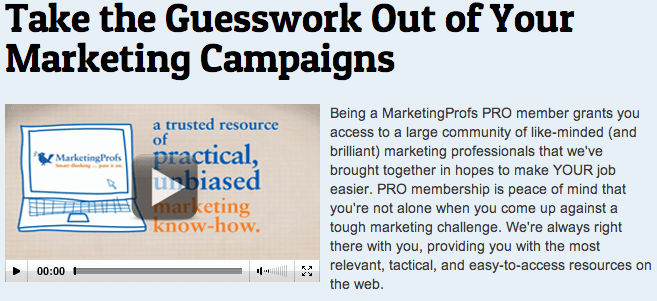
Ann: Exactly. So webinars is a great example. There are lots of free webinars out there, and a lot of them are decent. Why would you buy a pro membership with a year’s worth of webinars from MarketingProfs when there are lots of free webinars out there?
For publishers like us, it’s required us to up our game a little bit, basically. So our content is good. It’s always been good and so keeping up the quality is critical for us. But secondly, we’ve had to morph a little bit in the sense that we now offer longer training programs through MarketingProfs University, for example. That’s an effort to deliver something that most content marketers can’t or won’t do.
That’s an example of a way that we need zig when everyone else is zagging. Events, for example, become much more important as what we’re all about, but then also content as a service. We always had a big advertising sponsorship part of who we are, and so also what we’re doing now is creating content on behalf of brands that come to us and say, either because they want our content chops or because they want our credibility, we’re either creating branded content or white label content for companies.
So content as a service is increasingly part of what we’re all about. There are different things that we’re doing to differentiate. This is an interesting world that we’re in where everybody’s a content creator. What happens to the original content creators? I think we’re doing a great job there. We’re doing well. We’re still here.
Customer First, Of Course
Ann: I wanted just to mention one other thing too that you just reminded me. I just talked about it today at New Media Expo, but especially for B-to-B companies, it’s all about great content that your customers will thank you for. And I think the shift there is that you’ve got to really think about your customer first and I think a lot of companies say that, “Of course we think about our customers.” But do you really? I was talking to my friend, Joe Chernov, yesterday and he said something that I think is really smart so I’m going to steal it right now:
 Pretend that your customer signs your paycheck, not the CEO. How would that change your content? How would that change your marketing? I think that’s the question that a lot of content creators need to ask themselves when they’re creating content on the behalf of brands. Because right now I still think that we’re in this mindset that we’re creating content that our CEOs will love, that our shareholders will find awesome.
Pretend that your customer signs your paycheck, not the CEO. How would that change your content? How would that change your marketing? I think that’s the question that a lot of content creators need to ask themselves when they’re creating content on the behalf of brands. Because right now I still think that we’re in this mindset that we’re creating content that our CEOs will love, that our shareholders will find awesome.
But the reason why you want to think about your customer first is because if your customer is happy with your content, then your CEO is also going to be happy, then your shareholders are also going to be happy. But the inverse is not true. If your CEO and your shareholders love your content but your customers don’t like your content, then you’re nowhere, you’re not doing your job. So that’s the shift that I think more and more companies need to really embrace.
Jay: I absolutely agree. It doesn’t matter whether it’s an infographic or a video or a SlideShare presentation or a tweet. A brochure is a brochure is a brochure. It’s just a brochure in new media clothing, and people can see that coming a mile away. So I always tell people: if it feels at all like maybe you’re being a Trojan horse, you are.
Ann: Exactly. It’s a mental shift more than anything else to embracing that idea that if you provide value to people that they will thank you, they will come back and they will do business with you, they’ll remember you. I understand that that’s a huge mental shift.
Social Pros Shoutout
Jay: Fantastic. Do you have, as we wrap up the show, a couple of Social Pros shoutouts, people who inspire you or matter to you in the world of social media and content marketing who do not get the attention they so richly deserve?
Ann: Yes. One of my shoutouts would be to my good friend Tim Washer. Has he ever been on your show?
Jay: He has not been on the show but we’re going to make that happen. He is a hilarious guy. He’d be great.
Ann: He is hilarious. He’s a great guy. He works in video creation for Cisco. He’s not just hilarious but he’s really smart in the way that he thinks about content and just in life in general.
Another mutual friend of ours I would say is Matthew T. Grant. He does a tremendous job with the MarketingProfs podcast, Marketing Smarts, and I’ve actually learned a lot from listening to his podcasts about how he interviews people. And what I especially love about the way that he approaches his podcasts is that he comes at it with a sense of humility. He doesn’t come at it as the smartest person in the room. “I have to admit,” he says when he talked to Guy Kawasaki, “I’ve actually never been to a Google hangout. What is it?” And I love that. Most people who you and I know would be embarrassed to admit that, but Matt is just right out there. I love his honesty and his humility.
Jay: Excellent. Thank you very much, Ann. Next week on the show, as mentioned, Sandy Carter from IBM. Eric will be back. We’ll do the regular show, not live in the hallway. As always, thanks very much for listening.
See you next week!
